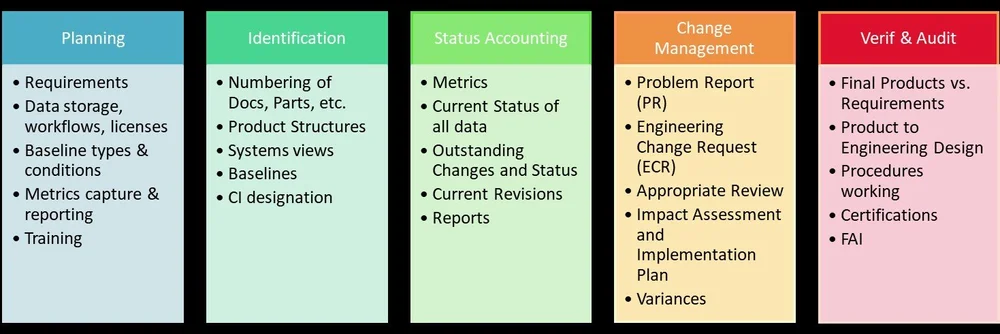Hardware Configuration Management
Inside Hardware Configuration Management Software :
What is Hardware Configuration Management (HCM)?
Hardware Configuration Management (HCM) is the application of configuration management to the hardware or physical components of the item(s) whose lifecycle configuration is the focus. Hardware Configuration Items (HCI) refer to each of the locally-related components of a product that require formal procedures for their release and control, including all associated information, documentation, and data. Learn more about the use of HCI in the A&D industry HERE.
HCM is often mistakenly thought of as being limited to the CM of hardware assets used in Information Technology devices, computers, networks, facilities, and related digital systems, but that is only one application of HCM.
Hardware Configuration Management is different from Software Configuration Management (SCM), but HCM can include the management of software items. SCM is the application of configuration management to software, embedded software, or firmware of software applications, products, equipment, and systems. True SCM involves much more than simple software version control, just like HCM requires much more than engineering change control. And it’s important to note that software configuration management is not the same as configuration management software, despite search engines and software directories mistakenly confusing the two terms.
Because many products and systems now include both hardware and software elements, configuration management training, standards, best practices, planning, and software tools must address the needs of both domains. However, the requirements and uses of software configuration management and software version control are a branch of configuration management that is served by consultants and providers of specialty tools used only in software development and software maintenance.
The 2017 NASA publication “Software and Hardware Configuration Management” provides further useful definitions and references. Learn more about hardware configuration management in these CMsights articles.
Who uses Hardware Configuration Management Software?
While the use of configuration management first arose from the A&D industry, there are now numerous industries where the complexity of products, along with their operation and maintenance, require HCM tools. The use of HCM software can be found in the following industries:
Aerospace, Aviation & Defense
Automotive
Consumer Products
Energy & Renewables
Heavy Machinery
High-Tech & Electronics
Industrial Equipment & Automation
Logistics & Distribution
Manufacturing & Supply Chain
Marine & Naval
Medical Equipment
Transportation & Mobility
Learn more about these industry uses of HCM HERE.
The users of Hardware Configuration Management software, and consumers of the data generated, within these industries can be found in many organizations across the enterprise. These groups can include:
Contracts & Requirements
Project & Program Management
Product Portfolio Management
Design Engineering & New Product Development
Procurement & Logistics
Manufacturing & Supply Chain
Quality Assurance & Test
Compliance & Sustainability
Technical Publications & Documentation
Customer Service & Warranty
Maintenance & Overhaul
Specific roles within these groups that use HCM software or access and use the data produced by HCM software can include:
Project Managers
Design Engineers
System Engineers
BOM Managers
Data Managers
Configuration Specialists
Change Board Members
Configuration Librarians
Procurement Buyers
Quality Inspectors
Logistics Engineers
Compliance Officers
Technical Writers
Customer Support Representatives
Service Technicians
Maintenance Personnel
To read more about who really are the users of CM, read this article CMsights on CM Users.
What are the functions of Hardware Configuration Management Software?
Hardware Configuration Management software solutions must support the five high-level tenets of CM: configuration planning, configuration identification, configuration status accounting, configuration change management, and configuration traceability, verification and audit.
Like configuration management software for other applications, these capabilities are delivered by a set of basic CM functions and CM software features that include:
Product Structure Management
Baseline Identification & Specification
Configuration Item Management
Configuration Data Management
Configuration Identification & Control
Configuration Status Accounting
Configuration Rules
CM Processes & Workflows
CMII and EIA 649 Standards Implementation
Bill of Material (BOM) Management
Change Management & Reporting
Change Implementation and Impact Analysis
Change Effectivity Analysis & Management
CAD-Independent CM
Tracking of As-Designed, As-Built, As-Maintained Configurations
Warranty Management
Document Management
Configuration Planning Management
Reviews, Audits, and Compliance Reporting
LEARN MORE how CMstat’s latest product, EPOCH CM, offers the deep functionality to support all of the capabilities required of a comprehensive hardware configuration management solution.
Receive CMsights
Subscribe to CMsights News for the latest updates from CMstat on Configuration Management, Data Management, EPOCH CM, and EPOCH DM.
Request a Demo
See how EPOCH CM and EPOCH DM support industry standards and best practices in Configuration Management and Data Management


